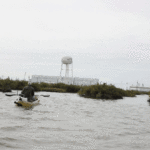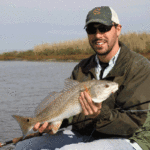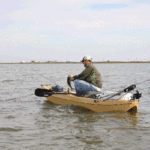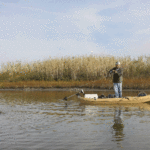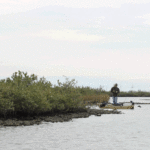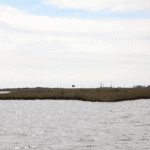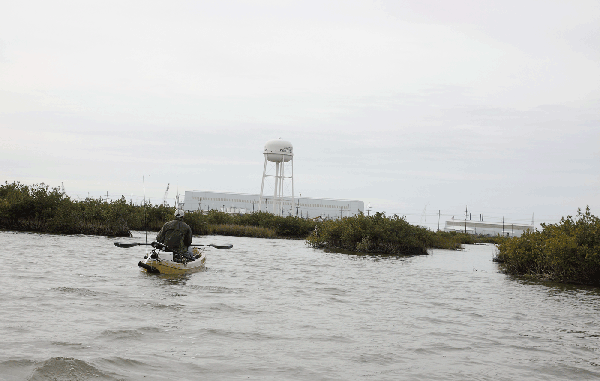
OK, so the water around Port Fourchon might not freeze, but the redfish are thick and waiting for you to paddle right up to them.
The Port of Fourchon is not the frozen tundra that Green Bay Packer fans so fondly depict their hometown as being. Nor do the surrounding waters of the port freeze, as some of those seen on the Discovery Channel’s “Deadliest Catch.”
But, that doesn’t mean this region doesn’t get downright cold, which just happens to impact the way anglers fish in the winter there.
When Kajun Custom Kayak’s Corey Coghlan invited me to do a little redfishing with him in one of the company’s kayaks at the Port of Fourchon, the idea of “freezing for fish in Fourchon” (note: something hard to say three times as fast as you can), was something I was willing to try.
After all, having grown up in Michigan and being familiar with ice fishing, cold wasn’t something that gave me much pause. On the contrary, I learned long ago that dressing in layered clothing makes all the difference when it comes to having a long, uncomfortable day or a pleasant one you wish to repeat.
If you start to perspire from increased activity,” as a kid back home that was shoveling snow,” it causes you to catch a chill that could lead to hypothermia.
So Coghlan suggested I wear neoprene chest waders because, 1) they would offer some extra warmth and 2) the paddles from kayaking would definitely drip some of that cold Fourchon water onto my clothing, which wouldn’t be good.
In all honesty, this would be my first trip fishing out of a kayak, of which I had little concern. I had paddled the Ausable River back home in a canoe as kid and Bayou Teche, Lake Martin and the ponds on my lease here in Louisiana as an adult.
My experience canoeing made me perfectly comfortable thinking there wouldn’t be a whole lot of difference in the handling aspects; in fact, getting around in a kayak would prove to be a whole lot easier.
There was just the weather to deal with and getting accustomed to the type of winter fishing we were doing.
All safety aside with respect to the elements, Coghlan’s knowledge of winter kayaking for redfish didn’t include an early start, which meant I could sleep in. He suggested we wait until 9 a.m. or so to let the sun warm the water a little.
What’s more, since we’d be doing some sight-fishing, he wanted to give the fish a reason to come up out of the deepwater holes to warm up in the clear-water shallows where we’d see them.
“Winter redfish are sluggish, and unless the bait is put right out in front of them, they don’t really want to take it,” Coghlan said, hoping the sun would burn off most of the overcast from a passing front around mid-morning. “But, at this time of year redfish overall are a lot more finicky, a little more sluggish and not really aggressive at taking the bait. So you don’t have to start fishing right at daylight. It’s better to let the sun come out and warm the water a little.”
He said the overcast could make our plans more difficult to accomplish.
“When the weather is overcast it makes it more difficult to see them if you’re sight-fishing in the winter and the water is clear,” Coghlan said.
Besides sight-fishing, we’d also be working a few of the holes and little passes near the port that were in the 4-foot deep range with which Coghlan was familiar. Additionally, we’d drift-fish oyster reefs in the shallow bay, stabbing a Cajun Marsh Anchor from time to time.
The nice part about the fishing trip was its close proximity to the Irvin P. Melancon Recreational Boat Launch and never out of site of the Port of Fourchon water tower, making it easy to stay oriented; something kayak novices and newcomers to the area will take comfort in. There’s nothing like fishing where access is easy and fish are relatively abundant.
But then, that’s typical along Highway 1 in this part of the state.
The deeper water near the clear shallows proved to be a key to Coghlan’s first catch of the morning. Where I chose to sit on anchor tossing baits into a little pass catching rat red after rat red that I was perfectly satisfied to cull through, Coghlan spotted what he thought to be a redfish’s tail fin in the shallow water along a nearby shell bank.
I was close enough to watch the stalk unfold. Going into stealth mode, there was nary a ripple or wake from the Kajun Kayak as Coghlan maneuvered the craft closer to the red.
Stopping, he picked up his fly rod and made a cast out in front of the fish, stripping a fly-spoon back towards him.
Suddenly, the water erupted.
“There he is,” that’s what we’re looking for!” Coghlan exclaimed.
Putting the red in the ice chest fixed to his kayak, Coghlan said the fight is fun but short-lived.
“They’ve got about one little run in them and that’s about it,” he explained. “They don’t fight as much in the winter. A lot of times, when it’s cold they’ll get shallow, but it’s always where there is access to deep water
” In the winter in the clear water, they’re a little more skittish and a little more finicky. In the summer the water is a little murky, where you can get closer.”
The angler said he used that knowledge to his advantage.
“So, what he was doing was coming up to get bait and moving back out to where I couldn’t see him anymore,” Coughlan said. “So, I threw out in the deep water, and that’s how I pulled him up close and he took the bait.”
Up until the moment Coghlan spotted his red, we were fishing a narrow pass pretty close together and no more than 20 yards apart. I asked him if he thought there was a higher probability of a rat red bite during the winter than one where we’d get into a steady catch of keepers like the one he caught on the fly.
“Not necessarily,” he answered. “But what happens is sometimes you get on a school, where all of the fish are of similar size. It’ll change, and all of a sudden you’ll start catching bigger fish.
“What I’ve learned when they,re biting is to always hang around. After several casts of catching non-keepers, you always land one that is a keeper.”
Coghlan compensates for finicky, skittish winter reds with the tackle he uses.
“Most of what we’re fishing in around the Port of Fourchon is pretty shallow and is going to be no more than 4-feet deep,” said Coghlan. “So, you,re not trying to get down really deep. I’ll use a light 1/8-ounce jighead. In other places I’ll use a ¼-ounce. But, in shallow water, I’ll throw lighter baits in the wintertime, something that doesn’t make a big splash and provides a lighter presentation. It often works a lot better.”
Coghlan’s preferred baits for fishing this region are clear with chartreuse H&H Sparkle Beetles and H&H purple and chartreuse cocahoe minnows.
“I catch a lot with what I use,” he said. “And, what I use have chartreuse tails. Down here,” being Fourchon and Grand Isle,” everybody has got their different baits that they use. But, this is what I kind of like to use and catch fish.”
Another winter fishing point that Coghlan pointed out besides the fish being finicky and skittish is the sluggish nature of the bite.
“Sometimes you have to fish real slow, the fish are so sluggish,” Coghlan said. “You’ll barely feel them hit it,” you’ll feel weight on the end of the line. And, they don’t fight as hard during the winter. But, you just have to work your bait slower along the shells on the bottom.”
Drift fishing near the port was simply fishing open water bays that can be anywhere from 1 foot deep to 4 feet deep, probing around until you caught a fish. Once you catch a red the idea is to stab your anchor, because Coghlan says sometimes you get into a big school of them. Together we didn’t get into any schools of reds, but Coghlan did pick up a couple, one a unique fish with multiple spots that reminded me of a leopard.
We kayaked little lagoons surrounded by scrubby mangroves just for variety and to get warm from being anchored too long in the bay. In the mangroves the water was extremely shallow, where the Kajun Kayak’s fiberglass hull and shallow draft made it remarkably easy to maneuver. What’s more, it was in the mangroves where I was able to catch my first kayak keeper after catching more than my share of rat-reds.
No, the days may not be as short during the winter in Louisiana as they are in Alaska. And, unlike Alaskans who get cabin fever, few Louisianans would be depressed if stuck in their camp during the winter down the bayou. But, especially if that camp is in Fourchon, where anglers can do a little wintertime kayaking for reds doing the Fourchon freeze…
